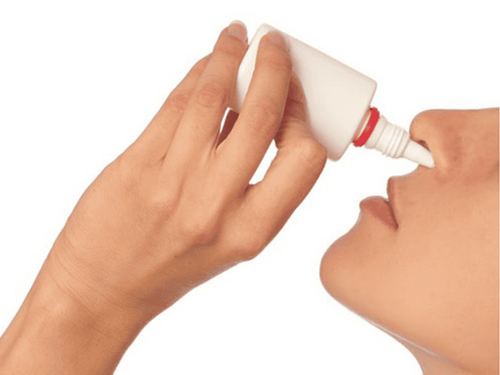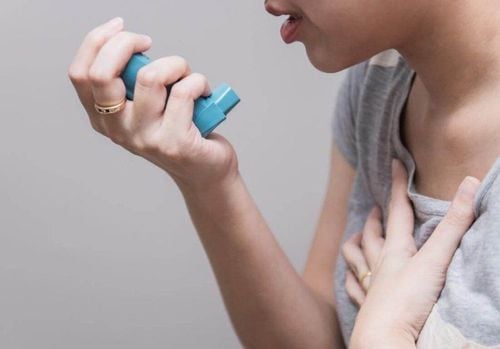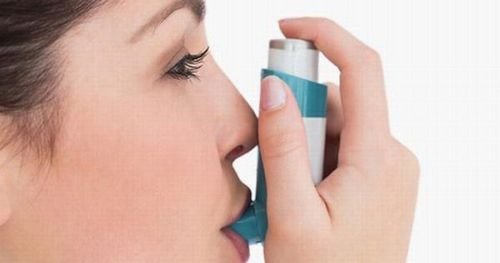This is an automatically translated article.
The article was professionally consulted by Doctor Tran Mai Phuong - Pediatrician - Neonatologist - Department of Pediatrics - Neonatology, Vinmec Central Park International General HospitalAsthma or asthma in children is a respiratory disease that causes bronchospasm and increased mucus production, making it difficult for children to breathe. The cause of the disease is caused by many factors, especially the combination of local and environmental factors will make the disease more serious. Asthma in children needs to be investigated and treated promptly to avoid dangerous complications.
1. An overview of asthma in children
Asthma (also called bronchial asthma or asthma) in children occurs when the lungs and airways become inflamed when exposed to certain triggers, such as breathing in pollen or having a cold or a urinary tract infection. other respiration. Asthma in children can cause uncomfortable everyday symptoms that interfere with play, sports, school, and sleep. In some children, untreated asthma can cause dangerous asthma attacks.Asthma in children is similar to asthma in adults, but children face more challenges. This disease is one of the leading causes of high rates of hospitalization and emergency department admissions for children. Unfortunately, childhood asthma cannot be cured and symptoms can continue into adulthood. But with standard treatment, children can control symptoms and prevent damage to their developing lungs.
2. Symptoms of asthma in children
Common asthma symptoms in children include:Cough often increases in children with viral infections, occurs while the child is sleeping or is triggered by exertion or cold air. Hissing or wheezing sound when exhaling. Shortness of breath. Chest congestion or tightness. Asthma in children can also cause:
Difficulty sleeping due to difficulty breathing, coughing or wheezing. Coughs or wheezing that are worse with a cold or flu. Delayed recovery or bronchitis after a respiratory infection. Shortness of breath that interferes with movement or learning. Fatigue, possibly due to poor sleep. Symptoms of asthma vary from child to child and can get worse or better over time. Your child may have only one sign, such as a persistent cough or chest congestion. However, it is difficult to know if a child's symptoms are due to asthma. Recurrent or persistent wheezing and other asthma-like symptoms may be caused by bronchitis or other breathing problems.
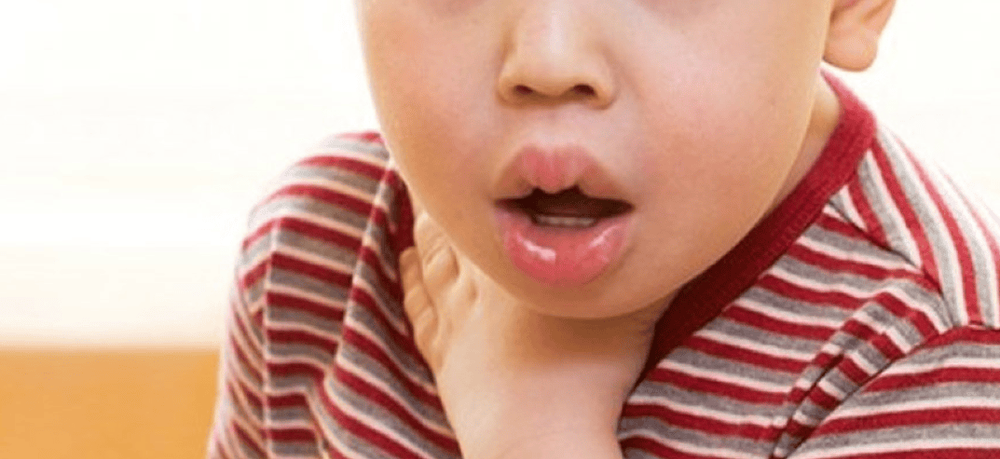
Trẻ khó thở khi bị hen suyễn
3. Causes of asthma in children
The causes of asthma in children are not well understood. Several factors are thought to be involved including:Allergies. Parents with asthma. Certain types of respiratory infections. Exposure to environmental factors, such as cigarette smoke or other air pollution. When exposed to certain agents, the immune system increases sensitivity, causing the lungs and airways to swell and produce mucus. These reactions may be delayed, making identification of agents more difficult. Some factors that can trigger an asthma attack include: viral infections such as the common cold, exposure to air pollutants, such as cigarette smoke, allergies to dust mites, pet dander, etc. pollen or mold, physical activity, change in weather or cold air. Sometimes, asthma symptoms occur without an obvious trigger.
4. How is asthma in children treated?
Initial treatment depends on the severity of the child's asthma. The goal of asthma treatment is to control symptoms, meaning the child has:Few or no asthma flare-ups. There is no limit on physical activity. Use reliever medications like salbutamol (Ventolin) to a minimum. Few or no side effects from the medication. Asthma treatment includes both prevention of exacerbations and treatment of ongoing asthma attacks. The right medication for a child depends on: age, symptoms, asthma triggers.
For children younger than 3 years of age with mild asthma symptoms, the doctor can continue to monitor, not using the medicine right away. This is because the long-term effects of asthma medications on infants and young children have not been proven. However, if an infant or toddler has frequent or severe episodes of wheezing, the doctor will prescribe a trial of medication and assess response afterward.
4.1. Long-term asthma control medications Preventive, long-term control medications reduce inflammation in a child's airways. In most cases, these medications need to be taken daily, including: Inhaled corticosteroids: These include fluticasone (Flixotide HFA), budesonide (Pulmicort Flexhaler), mometasone (Asmanex HFA), ciclesonide (Alvesco), beclomethasone (Qvar Redihaler). Your child may need to take these medicines for a few days to a few weeks before they show any signs of turning sick. However, long-term use of these drugs is associated with reduced growth in children, but the effect is not significant. In most cases, the benefits of good asthma control outweigh the risks of possible side effects.
Leukotriene modifiers: These oral medications include montelukast (Singulair), zafirlukast (Accolate), and zileuton (Zyflo). These medications help prevent asthma symptoms for up to 24 hours.
Combination inhalers: These drugs contain an inhaled corticosteroid plus a long-acting beta agonist (LABA). These include fluticasone and salmeterol (Seretide HFA), budesonide and formoterol (Symbicort), fluticasone and vilanterol (Breo Ellipta), mometasone and formoterol (Dulera). In some situations, long-acting beta-agonists have been associated with severe asthma attacks. For this reason, LABAs should always be used in combination with corticosteroids. These combination inhalers should only be used for asthma that is not well controlled by other medicines.
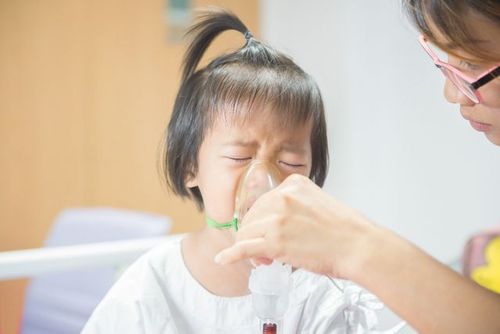
Điều trị hen suyễn ở trẻ em cần tuân thủ theo chỉ dẫn của bác sĩ
Theophyllin: This is a daily pill that helps clear the airways. Theophylline (Theo-24) relaxes the muscles around the airways to make breathing easier. It is mainly used with inhaled steroids. If taking this medicine, your child will need regular blood tests.
Immunomodulators: Mepolizumab (Nucala), dupilumab, and benralizumab can be used in children over 12 years of age with asthma with severe eosinophilia. Omalizumab (Xolair) may be considered for children 6 years of age and older with moderate to severe allergic asthma.
4.2. Reliever relievers Reliever medications work to relax swollen airways - also called emergency medications. Reliever medications are used when needed for quick, short-term relief of symptoms during an acute asthma attack or before exercise if recommended by your doctor. Relief medications include:
Short-acting beta-agonists: These inhaled bronchodilators can quickly relieve symptoms during an asthma attack. These include salbutamol (Ventolin HFA) and levalbuterol (Xopenex HFA). They work within minutes and the effects last several hours.
Oral and intravenous corticosteroids: These drugs reduce airway inflammation caused by severe asthma attacks, including prednisone and methylprednisolone. They can cause serious side effects with long-term use, so they are only used to treat short-term severe asthma symptoms.
5. Asthma in children in the cold season
It can be seen that asthma symptoms are influenced by the season. During the cold season, when the temperature drops, going outside can make breathing more difficult. Exercising in the cold can cause symptoms such as coughing and wheezing.The relationship between cold weather and asthma can be explained as follows:
Cold dry air: A child's airways are lined with a thin layer of fluid. When you breathe in dry air, that liquid evaporates faster than it can and the dry airways become irritated and swollen, worsening asthma symptoms. Cold air also causes the airways to produce a substance called histamine, which is a chemical your body makes to fight allergies. Histamine causes wheezing and other asthma symptoms. Cold increases mucus: A baby's airways are also lined with a protective layer of mucus, which helps to remove foreign objects. With cold weather, the baby's body will secrete more mucus, but it is thicker and stickier than usual. The thickened mucus makes the child more susceptible to colds or other infections. To prevent asthma attacks in children during the cold season, try to keep your child indoors when the temperature is very low. If you have to go outside, cover your child's nose and mouth with a towel to warm up the air before he breathes in. Also, it's a good idea to give your child extra water in the winter - this can keep the mucus in the lungs thinner and thus easier for the body to get rid of. Try to stay away from anyone who appears to be sick. Get a flu shot in the early fall. Vacuum and mop regularly to remove indoor allergens. Wash sheets and blankets weekly in hot water to remove dust mites.
If you have unusual symptoms, you should be examined and consulted with a specialist.
Please dial HOTLINE for more information or register for an appointment HERE. Download MyVinmec app to make appointments faster and to manage your bookings easily.
References: mayoclinic.org; webmd.com






